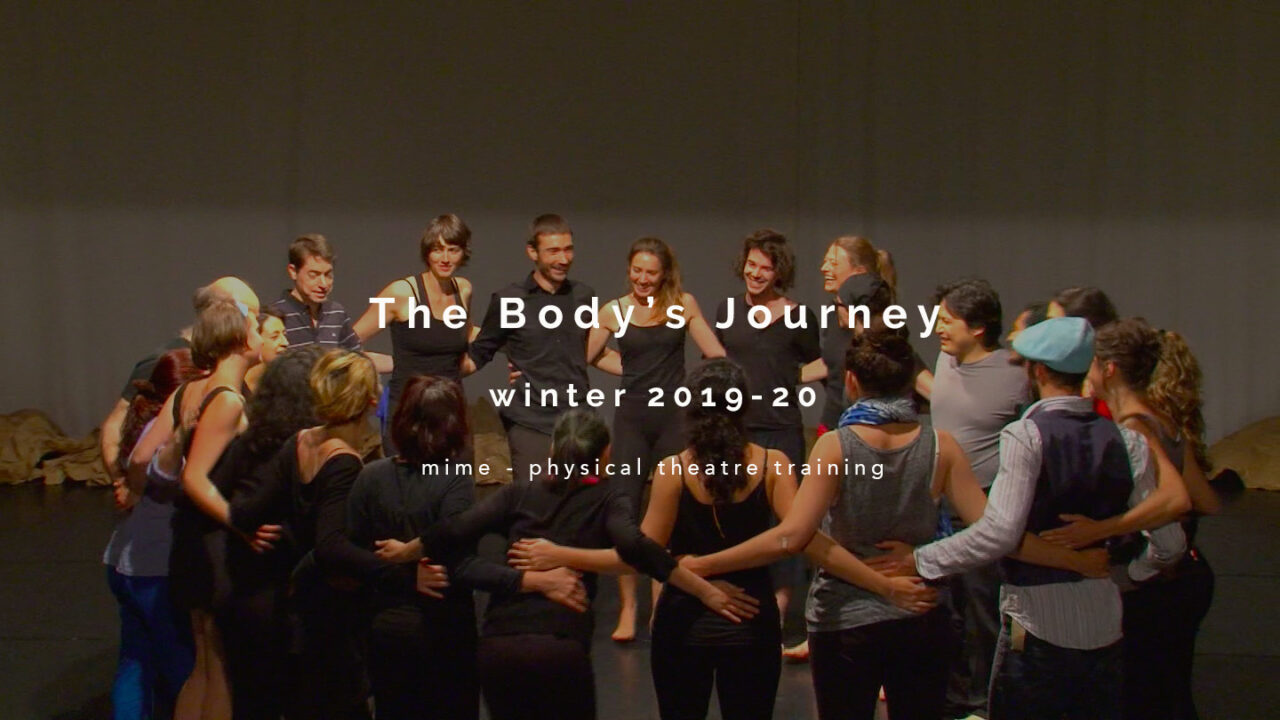Project of Training, Research, and Devising for actors/dancers/musicians/singers/puppeteers
The project The Body’s Journey is the fruit of more than 20 years of experience of Leela Alaniz in the theatre field (training, university research, teaching, devising). It concentrates on the fusion of two contemporary techniques for the actor/dancer training: The Organic Lineage research initiated and developed by Jerzy Grotowski; and the Corporeal Mime of Etienne Decroux. These different techniques find a commonplace in that they both develop through the actor/dancer the sense of scenic presence and autonomy as an author/performer/creator.
The exercises of the organic process liberate the energetic flux from the spinal column and propagate to transform the physical body. The actor/dancer thus develops a concentration and identifies with his physical, emotional and mental centers. Instead of searching for a specific expression, the actor/dancer plunges into a real process of organic research, which in turn becomes an artistic expression. The corporeal movements are initiated by impulses that are germinated from the interior of the body and develop within and throughout it. The research in theatre anthropology draws its inspiration from traditional theater from diverse parts of the world.
In the practice of Corporeal Mime, the actor/dancer finds the possibility of creating his or her own personal compositions in isolating different parts of the body, in mastering its articulations, and in playing with varying speeds, resistances and designs of corporeal movement.
The play and the joy of playing, and the improvisation are part of the listening and of the sharing. The research with materials, the acrobatics, the voice work (text and sing) and the exercises of awareness and awakening the interior are also part of our training work, research and creation.
Our project, The Body’s Journey, will guide actors/dancers on a road to self-discovery in order to explore new corporeal paths through the listening of impulses, abandoning of stereotypical and mechanical behaviors, and through the discovery and the respect of a genuine organicity inherent in the body. A corporeal work conducted with attention and sensibility allows the actor/dancer to develop an original language capable of communicating to a larger audience and to cultivate openness to one’s self and to others, recovered through the artistic training of theatre and performance throughout the ages and across cultures.[/az_column_text][az_divider div_type=”thin-solid-div”][az_column_text]This new edition of The Body’s Journey benefits from the valuable collaboration of experienced artists/masters including:
Won Kim – Practice: Improvisation, Play
Gennady Bogdanov – Practice: Meyerhold Biomechanics
Lluis Graells – Practice: Commedia dell’Arte
Training Program
Practice – with Leela Alaniz
- Exercises of the Organic Lineage – research of organicity, energetic flux, opening the blockages of the body, and of the release.
- Exercises of attention and interior awakening
- Stage Presence
- Acrobatics, Contact improvisation
- Corporeal Mime – Technique Etienne Decroux – articulations, counterweights, dynamo-rhythm, intra-corporeal and inter-spatial causalities.
- Alexander Technique – relaxation and liberation of the articulations
- Work with objects
- Voice – corporeal resonators, singing, breath, impulsion and dynamo-rhythm for text,
- Improvisations, play
- Compositions, structure
—
Practice – with Gennady Gogdanov
Meyerhold Biomechanics
We will explore the physical techniques of Biomechanics, a system of training created by Meyerhold that provides the actor the necessary tools to re-educate his reflexes; collaborating to move away his daily and mechanical movements; to build characters through a psychophysical approach; to play in a state of deeper concentration and thus master the scenic play.
- Work on rhythm – the “inner musicality”
- Work on the principles of Biomechanics, according to Meyerhold, natural and fundamental elements of the gesture, such as:
- Otkaz (the refusal): a counter-movement that serves both to prepare the action and to give the signal to the stage partner indicating that the actor is ready to react.
- Pacil (sending): the simultaneous commitment to the action and the action itself.
- Tormos (the brake): the constraint that the actor must simultaneously exercise with the force ahead of the pacil in order to maintain control.
- Totcbka (a point in space, the point at the end of the body sentence) or stoïca (posture). They indicate the culmination of an action at a specific point in space.
Practice – with Lluis Graells
Commedia dell’Arte
During the workshop, we will explore the masked characters of the Commedia Dell’Arte through the study of their walks, voices, and energies: Arlequin, Colombine, Dottore, Pantalon, Capitan, Zanni, Brighela. Each of these characters will be the object of a personalized work of each student. In this fixed form, in the “interior”, lies a large creative space that will be uncovered and will permit each actor to create his Arlequin, his Capitan, her Colombine…
Each day, improvisation will take its special place. We will study the codes of acting specific to the Commedia and to the mask, as well as the construction of the storylines. These participants will create the intrigues and mysteries by relying on the physical form and the social functions of their masked characters, based on their proper imagination and their relations tied to the characters.
- Semi-mask: movement techniques, lecture and study • Fixed Type, Type/Countertype, Style, Attributes
- Corporeal Schema of the Character and the Physical Transformation of the Actor
- Technical Limitations as a Source of Creation
- Improvisations as show
—
Practice – with Won KIM
- Improvisation, Play.

